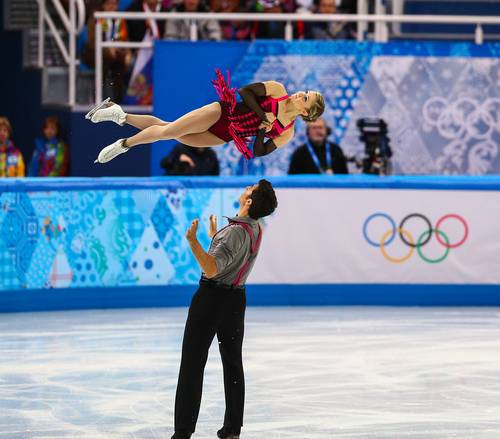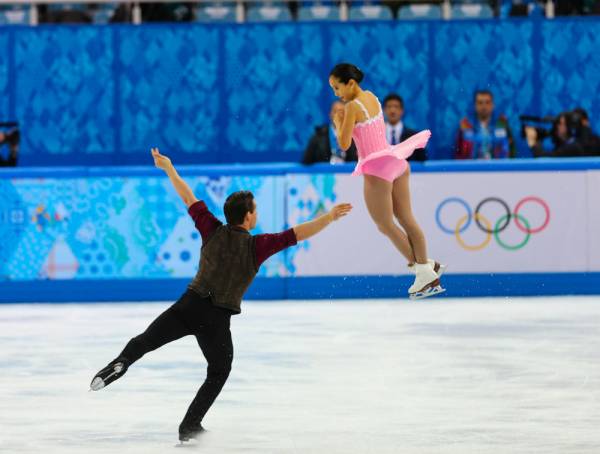Many Breaking Muscle readers have taken to watching the Winter Olympic Games from Sochi this month. During the broadcast, several product advertisements or feature stories have highlighted America’s finest athletes working out – and in particular, squatting.
Sports such as alpine skiing, bobsled, and ice hockey have engaged in serious strength training for many years. Fans, however, may wonder about the relevant application of sound weight training methods to other winter sports. Suffice it to say, all athletes at this level engage in some form of resistance training, either as an injury prevention practice or for performance enhancement. But what about true weightlifting training? Well, even in sports as remote as skeleton, fourth place Team USA member Katie Uhlaender sang the praises of her weightlifting training in Shreveport, Louisiana under the supervision of Kyle Pierce, the director of the USA Weightlifting Development Center there.1
The Case for Figure Skating
My first real exposure to figure skating occurred just after the 1992 Olympics, when I was enlisted to serve as a strength coach for a men’s junior world championship figure skating silver medalist. The opportunity greatly expanded my awareness of this sport, its physical demands, and the amazing amount of time skaters spend on the ice throughout the day. So much time was devoted to on-ice training that off-ice training became a matter of “when do we fit it in?”
Selling true strength and power training to a non-strength or power athlete is often a challenge. My young charge was not convinced of my approach and his adherence to a periodized strength-training program was poor. He wanted to spend more time on the “pec-deck” (“I need this to help with my spins”) than on squatting. We never got to any of the more serious training that could have quickly provided additional on-ice benefits. As I struggled to establish a reasonable approach with this athlete, I recalled a relevant story I’d heard earlier that connected the benefits of weightlifting training for figure skating.
Indulge me for a brief, but related, history lesson. The US Olympic Committee’s first attempt at a training center took place at Squaw Valley, California in 1979. The idea of training centers resulted from the Amateur Sports Act of 1978 (now revised as the Ted Stevens Olympic and Amateur Sports Act).2 This massive legislative act came about in reaction to small East Germany’s greater gold medal count than the USA’s in the 1976 Summer Olympic Games.
Weightlifters training for the 1980 Moscow Summer Olympic Games shared training facilities with athletes from several sports, including Randy Gardner, the pairs figure skating world champion from 1979 (with Tai Babilonia). I became USA Weightlifting’s first national coach in 1981 at the larger, permanent Olympic Training Center in Colorado Springs. Several of my lifters reported that Gardner was capable of clean and jerk lifts in the 220lb range – certainly an outstanding effort for a non-weightlifter. This total-body, ground-based exercise certainly makes a lot of sense for someone who repeatedly lifts and throws their partner into the air, on skates, no less.
How and Why Such Training is Relevant
 Noted sports biomechanist John Garhammer has investigated the power output in weightlifters of both genders and all abilities. He has repeatedly shown that elite male lifters generate as much as 5,500 watts of power during the so-called second pull phase of the snatch or the clean, and approximately the same amount in the jerk portion of the clean and jerk.3 These lifts all involve rapid and coordinated triple extension of the ankle, knee, and hip joints, similar to the jumping actions of various sports.
Noted sports biomechanist John Garhammer has investigated the power output in weightlifters of both genders and all abilities. He has repeatedly shown that elite male lifters generate as much as 5,500 watts of power during the so-called second pull phase of the snatch or the clean, and approximately the same amount in the jerk portion of the clean and jerk.3 These lifts all involve rapid and coordinated triple extension of the ankle, knee, and hip joints, similar to the jumping actions of various sports.
By comparison, the so-called “power” lifts of the squat, bench press, and deadlift reportedly create between 300 and 1,100 watts of power. Gardner was no doubt a bit of a pioneer more than thirty years ago, but he recognized the benefits of training a total body, multiple-joint movement like the clean and jerk with weights well beyond those he typically experienced in his event.
Fast forward more than thirty years and we today find that explosive training has gained tremendous support from sports coaches of many, if not most, disciplines. A recent survey of high school strength coaches found that 97% use Olympic-style lifts in the training of their athletes and that 78% rated the clean as the number-one or number-two “most important exercise.”4
Training explosively, that is, attempting to move a mass at the fastest possible speed, is advanced training. It is important to first lay a proper foundation with bodyweight resistance exercises (pull-ups, dips, etc.), followed by general weight training or bodybuilding protocols to prepare the muscular system for the more challenging weightlifting-specific exercises. But, with proper preparation, most athletes benefit from moving into more serious strength and power exercises, including those found in the sports of powerlifting and weightlifting.
Final Thoughts
 We can safely conclude that most Olympic-level athletes at the Sochi Winter Games are training with weights. Some may be performing simple, basic exercises that at least may balance their muscular development or prevent injury. But, I’m willing to bet that more than we might expect are engaged in advanced training, such as weightlifting-specific exercises.
We can safely conclude that most Olympic-level athletes at the Sochi Winter Games are training with weights. Some may be performing simple, basic exercises that at least may balance their muscular development or prevent injury. But, I’m willing to bet that more than we might expect are engaged in advanced training, such as weightlifting-specific exercises.
Included here is an excellent example of good weightlifting technique in the clean and jerk exercise, demonstrated by strength coach and first-year weightlifter, TJ Greenstone. TJ, lifting in the +105kg (superheavyweight) category, needed this lift (185kg, 407-¾lbs) to garner the bronze medal in the 2013 American Open Weightlifting Championships. He’ll never be mistaken for a figure skater, but athletes from any sport would do well to emulate his technique.
Check this out and see if your athletes could benefit from such training. Click on the arrow indicators to see the various positions that make up the entire movement.
References:
1. “Hall of Fame Class of 2012 – Ted Stevens,” TeamUSA.org, accessed Feb 2014.
2. “Level 1 Sports Performance Coaching Course” manual, USA Weightlifting, January 2010, page 3.
3. Duehring, et al, “Strength and Conditioning Practices of United States High School Strength and Conditioning Coaches,” Journal of Strength & Conditioning Research, Volume 23, Issue 8, November 2009, 2188-2203.
Photos courtesy of Shutterstock.






